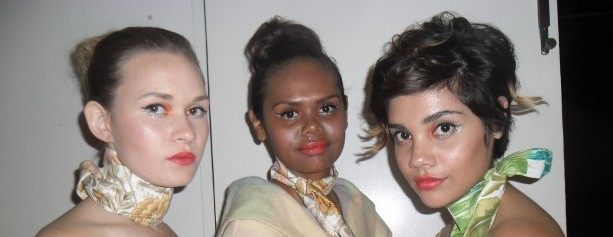More than 30 models showcased indigenous fashion on Saturday for Melbourne Spring Fashion Week (MSFW). The Indigenous Runway involves collaboration between Indigenous people starting out in the fashion industry through the mentorship program, Global Indigenous Management.
The runway presented Aboriginal, Pacific Island, South Sudanese, Māori and Native American designers’ work on the runway.
Most of the female models had never walked in heels before, but Tina Waru, program director, is proud they could pull it all together in the end.
“We had one young model’s heels bleeding from blisters, but she kept on walking,” Ms Waru said.
The male models walked barefoot and often shirtless, with feathers, beading and woven materials around their bodies for the purpose of expressing cultural stories through fashion.
The sentiment among the crowd was one of excitement, many there to support their brothers and sisters’ introduction and transition into the fashion industry.
Ms Waru explained to Catalyst that sometimes, indigenous peoples refer to one another as brothers and sisters due to the shared understanding of trauma from colonisation. In light of that, the event promoted connectedness between cultures.
Indigenous media personalities attended, including NITV presenter Leila Gurruwiwi and ambassador of the Indigenous Runway, actor Mark Coles Smith.
Pop singer and past X-Factor contestant Shanell Dargan opened the event with the emotional Whitney Houston song, ‘I Will Always Love You’, after a Welcome to Country by Heather Kennedy.
“I feel that Indigenous girls and boys are stunning. But a lot of people outside of Australia don’t know who [Australian] Indigenous people are. People I know from America, before they met me, they didn’t even realise there were black people in Australia,” Shanell Dargan told Catalyst.
During Robbie McGuinness’s dance performance, as an introduction to the Aboriginal designer section, his body glittered in zigzags of neon orange and sparkly makeup to represent traditional body paint.
Mr McGuinness uses dance as a way to tell stories to his audience about his Indigenous culture. He said he continues to be a part of the Indigenous Runways to support its positive body message. Indeed, while all female models during the event were considerably tall, their sizes ranged from 6 to 12.
“We celebrate the curves of our women and our staunch men. We don’t stick to what the media portray us as,” Mr McGuiness said.
He will be performing at the Melbourne Fringe Festival as an Aboriginal dancer.
Shanell Dargan’s manager Zach Green runs Chance Management, which supports indigenous music artists including the rapper Miss Hood.
“This event is about expressing to Australia, and the world as well, that Aboriginal people are very talented,” Mr Green said.
Jesse Weetra, 16, was one of the younger models there. She told Catalyst after the show that she’s always wanted to be a model, but walking down the runway is pretty nerve-wracking.
Māori designer Jeanine Clarkin’s collection that Jesse Weetra modelled included chambray hoodies with sleeves made from woollen second hand blankets. Another stand out collection was ‘Afro Oz’, featuring African prints with Emu feathers.
“It took hours to sew the feathers to the bottom of the crop tops,” designer Nyibany Mayom Tulba said.
Native American fashion was flown in especially for the event, modelled to the backdrop of a reflective photo gallery. Specific music was played during each segment in the show to convey specific stories of indigenous peoples.
The established permanent collection of Natasha Dwyer was also part of the runway, including the Miss Universe Australia dress Jesinta Campbell wore last year to the Miss Universe Pageant.
The Indigenous Runway went for two hours, a stretch from most runways at MSFW, which clock to only 30 minutes. There was an overwhelming applause from the audience, but especially in the private de-briefing, where family members and models were crying with joy.
“We told a story about connecting between cultures, and that meant the world to us,” Ms Waru said.
By Roisin Kelly-Goldsmith
Photo credits: Jeanine Clarkin (cover photo) and James Henry photography


